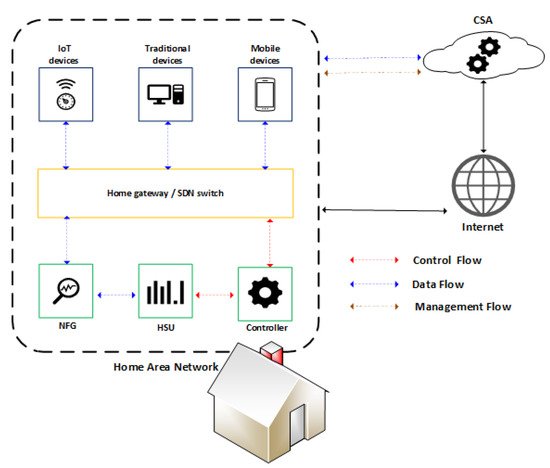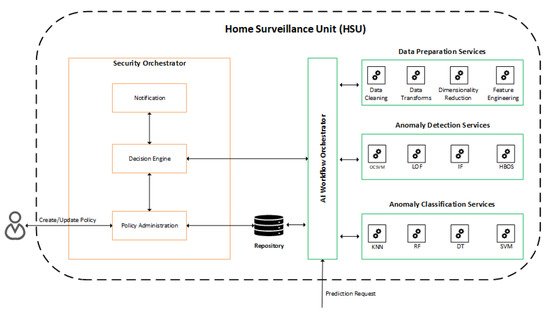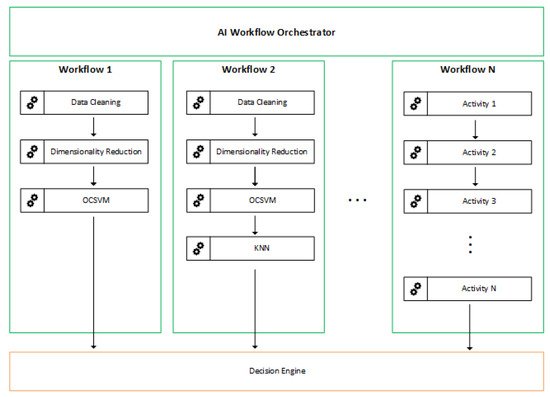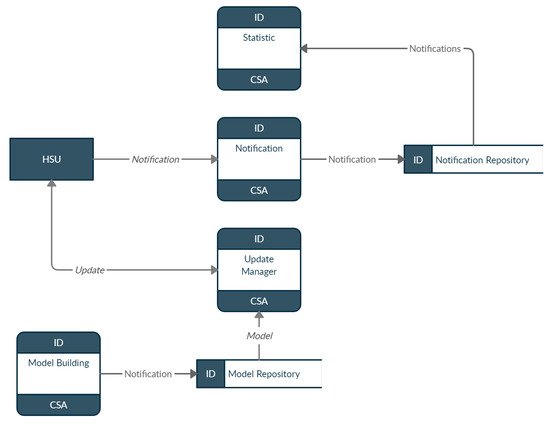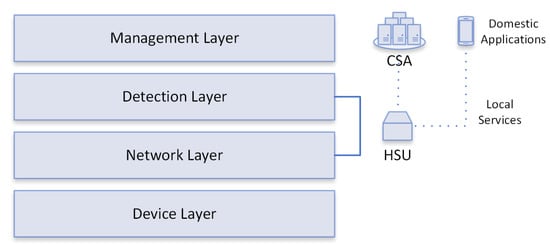A smart home is a communication network that connects sensors, appliances, controls, and other devices to enable remote monitoring and control by occupants and others to provide frequent services to residents and the electrical system. Therefore, we can say that this concept is closely linked to the term Internet of things (IoT) because smart homes provide facilities for the occupants of the residential environment and interconnect objects and sensors.
Based on these questions, we can conclude that implementing traditional security mechanisms to tackle problems in smart homes may not be the best strategy. Therefore, it is necessary to explore the use of alternative approaches. One of them is using a Software Defined Networking (SDN) that, when applied to the IoT context, will change the network from a static to an adaptive or programmable state, which is a necessary feature in a heterogeneous environment.
3. FamilyGuard
FamilyGuard is a security architecture designed for smart homes equipped with different types of computing devices. The main goal of FamilyGuard is to anticipate and respond to the needs of residents, working to promote their comfort, convenience, safety, and entertainment. According to [
42], home environments lack reliable security solutions since households occasionally only have antivirus software installed on computers and rarely have perimeter defenses installed on their networks such as an intrusion detection system (IDS) or a firewall. Besides, our systematic literature survey presented in
Section 3 showed that proposed solutions only focus on IoT devices and ignore the other communication devices present in the HAN. Our solution serves the entire residential environment, detecting threats in IoT and mobile and traditional devices, such as computers and laptops.
Figure 1 presents a high-level view of the architecture. Security service providers (SSPs) are responsible for providing management and configuration features that help protect existing information on a home area network (HAN), such as machine learning (ML) models to identify anomalies in network behavior. The user can access the services provided by SSPs through an application on their mobile device and hire a Security-as-a-Service (SECaaS) that meets their needs. HANs can send information and alerts to SPPs if they identify anomalous situations in the network. In this way, by managing multiple households, an SPP can work collaboratively to detect threats.
Figure 1. High level architecture. The user can access some of the security services provided by SSPs using mobile devices.
Each family living in a smart home environment has specific needs. Therefore, besides dealing with the heterogeneity of devices, it is necessary to address the specificities of each smart home environment. We will tackle this issue by analyzing the inbound and outbound network traffic. With this in mind, we propose the following essential components of FamilyGuard: Home Surveillance Unit (HSU), controller, network flow generator (NFG), and Central Security Assistant (CSA). Figure 2 shows each of the components in the environment and how they communicate.
Figure 2. Communication between the architecture components.
The NFG receives network packets transmitted by the home gateway and generates network flows analyzed by the HSU. Upon identifying any anomalous behavior, the controller receives a notification, and the device involved in the anomalous behavior can be blocked to mitigate potential threats. The rules that determine the actions to be taken when identifying a threat depend on the HSU configuration; it may issue only a notification or completely block device communication.
3.1. Home Surveillance Unit (HSU)
The HSU is responsible for receiving flows from the network, performing traffic analysis tasks, and managing the network through the controller interface. The HSU uses a workflow to handle incoming network traffic flows and perform analysis. A workflow can contain multiple artificial intelligence models to handle flows and perform analysis sequentially. For example, the HSU receives a flow and forwards it to Workflow A, which initially prepares the flow by removing unnecessary characteristics; another model identifies the traffic type of the flow and forwards it to the last model to verify if the flow has anomalous behavior. The structure HSU has two main components: the Security Orchestrator and the AI Workflow Orchestrator, shown in Figure 3 and described below:
Figure 3. Communication between the services present in the HSU.
-
Security Orchestrator (SECOR): is responsible for managing, configuring, and providing notification information related to security policies applied in HAN. Upon receiving the result of a prediction from the AI Workflow Orchestrator, the decision engine checks the applicable security policies to defeat or mitigate the detected threat and then notifies the controller so that the change in the flow table is performed to block or limit access to the device on which the threat was detected. The user can also change the security policies, being able to choose to either block the infected device immediately or be notified and make the blocking decision later.
-
AI Workflow Orchestrator (AIWO): in charge of receiving prediction requests and generating results for the Security Orchestrator, being also responsible for managing and administering services available for predictions, categorized as Data Preparation Services, Anomaly Detection Services, and Services of Anomaly Classification.
Figure 4 exemplifies the structure of the AIWO, which allows for the definition of multiple workflows using a set of available models. SSPs and users are set free to create and define workflows to meet specific HAN needs with this structure. For example, we can have workflows that identify anomalies in specific scenarios, such as in IoT devices, and ignore traditional home devices, such as notebooks and personal computers.
Figure 4. Workflow Orchestrator is responsible for managing several workflows.
It is essential to highlight that we can have several workflows in operation; however, a prediction request does not have to go through all workflows. AIWO allows a configuration in which flows from certain devices are routed to specific workflows. In this way, we can have models that identify anomalies at a lower level of granularity.
3.2. Controller
The SDN controller is installed in a computing device responsible for receiving the HSU instructions and relaying them to the home switch (HS), where all devices in the home must be connected using wired or wireless connections. The approach used in this work was to deploy the HSU and the controller on the same device. The main advantage of running the HSU with the controller was maintaining a simple deployment scenario in a smart home, avoiding using another device to execute the HSU instructions. Performance is another aspect that motivated this decision, as the exchange of messages between the controller and the HSU is faster when they are on the same device.
Using an SDN controller in the scope of a residential environment could bring several advantages such as greater agility, more programmability, centralized data control, simplified operations, and better management of network resources. The HSU, for example, can send a blocking rule to the controller when it identifies a threat. In this way, the HSU takes advantage of the dynamism provided by the use of the controller to actively act on the network to mitigate threats that could harm users’ privacy.
Despite its benefits, adding an SDN controller in a residential scenario might not be a simple task for a user. However, for the scenario involving smart homes, a small device with low cost and good computing power can meet this need. The ISP or SSP can also provide an SDN-based device when offering such a solution for home users. The potential complexity for end users in dealing with an SDN controller is eliminated by adopting the FamilyGuard architecture, which performs all the management (communication) of the controller and provides APIs for developing web pages or mobile applications to control their devices and information.
3.3. Network Flow Generator (NFG)
The NGF component collects traffic that traverses a given network, or network segment, to generate [
43] network flows. According to RFC 7011, a flow can be defined as a set of IP packets passing an observation point in the network during a specific time interval. Network flows have been used in several network applications ranging from troubleshooting connectivity issues to planning future bandwidth allocation. Here, we use network flows to identify and mitigate security issues.
Monitoring network flows can provide insights into how a network operates, its overall utilization, application usage, potential bottlenecks, anomalies that can signal security threats, etc. Several different standards and formats are used in monitoring network flows, including NetFlow [
44], sFlow [
45], and Internet Protocol Flow Information Export (IPFIX) [
46].
The adoption of a solution to generate network flows is encouraged by the benefits of detecting anomalous traffic and other threats to network security. The information in the IP packet header provides the basis for generating network flows. The amount of data processed by the flow-based intrusion detection system is less, as it contains summary information. Another factor contributing to the decision to use network flows for analysis is the number of network applications that use end-to-end encryption. Since flow-based inspection only works with statistical features extracted from the packet header, this approach raises fewer privacy concerns than packet-based inspection because user information is protected from any intermediate scans.
Despite the benefits, flow-based intrusion detection also has some limitations. For example, the network flows represent a snapshot of summarized network traffic at a specific time. Therefore, it might be more difficult to distinguish some attack types [
47].
3.4. Central Security Assistant (CSA)
The CSA aims to provide services that collaborate with the performance of the activities by the HSUs. The CSA can be provided by Internet Service Providers (ISPs) or by service providers interested in providing an adequate structure for the management of security in residential environments.
The flexibility in CSA positioning allows the architecture to be employed in the smart home context and in different IoT environments such as smart grid, healthcare, and others. However, it is necessary to evaluate, among other things, the number of devices deployed on the network and the traffic generated by them to define the hardware resources needed to meet the environment. One of the benefits of installing CSA on an ISP or cloud is the ability to sell security services to customers as models for detecting threats.
Figure 5 presents the data flow performed by the CSA, in which the notification process receives notifications provided by the HSU and saves them as notifications in the notification store. The CSA also runs the statistics process, which is responsible for creating metrics based on notifications received by the HSU. In addition to notifications, the CSA maintains the anomaly detection models used by HSUs.
Figure 5. Communication between CSA components.
Thus, the model building process is responsible for building these models and saving them in the repository. The update manager process can perform queries to check the models for updates and send messages notifying the HSU if there are any updates.
The architecture’s conceptual design aims to detect anomalies, allowing for the management of heterogeneous IoT devices deployed in smart home environments, and also focuses on the analysis of activities generated in the network. Therefore, a multi-layer structure was adopted that allows for the independent development of the components.
3.5. FamilyGuard Layers
FamilyGuard is organized into four layers: Device layer, Network layer, Detection layer, and Management layer, depicted in Figure 6. The HSU and SDN controller operate at the Network and Detection layers. The Management layer hosts (i) the CSA, which helps different HSUs to perform their tasks, and (ii) applications, which help to control and configure local services that exist in residential environments. The structures of each layer are described below:
Figure 6. FamilyGuard layers and their relationship with HSU and CSA.
-
Device Layer: represents all devices that can communicate in home environments, including laptops, smartphones, and smart devices such as sensors (temperature and presence) and actuators (light switches). There are several smart devices on the market, created by different manufacturers; therefore, residential environments are heterogeneous and complex for risk and threat management.
-
Network Layer: has the ability to handle multiple protocols and receive/transmit data through the Devices layer, so that data packets are transferred over the data link, such as Wi-Fi, Ethernet, Wireless Sensor Network (WSN), and Machine- to-Machine (M2M).
-
Detection Layer: performs anomaly detection (primary function) through well-defined services, from network traffic reception to notification, for layer management, by classifying a given flow as anomalous.
-
Management Layer: is responsible for monitoring and controlling the settings of the residential environment through CSA and home control apps; the CSA collaborates so that HSUs can perform their functions through services that are essential for the functioning of the environment.

